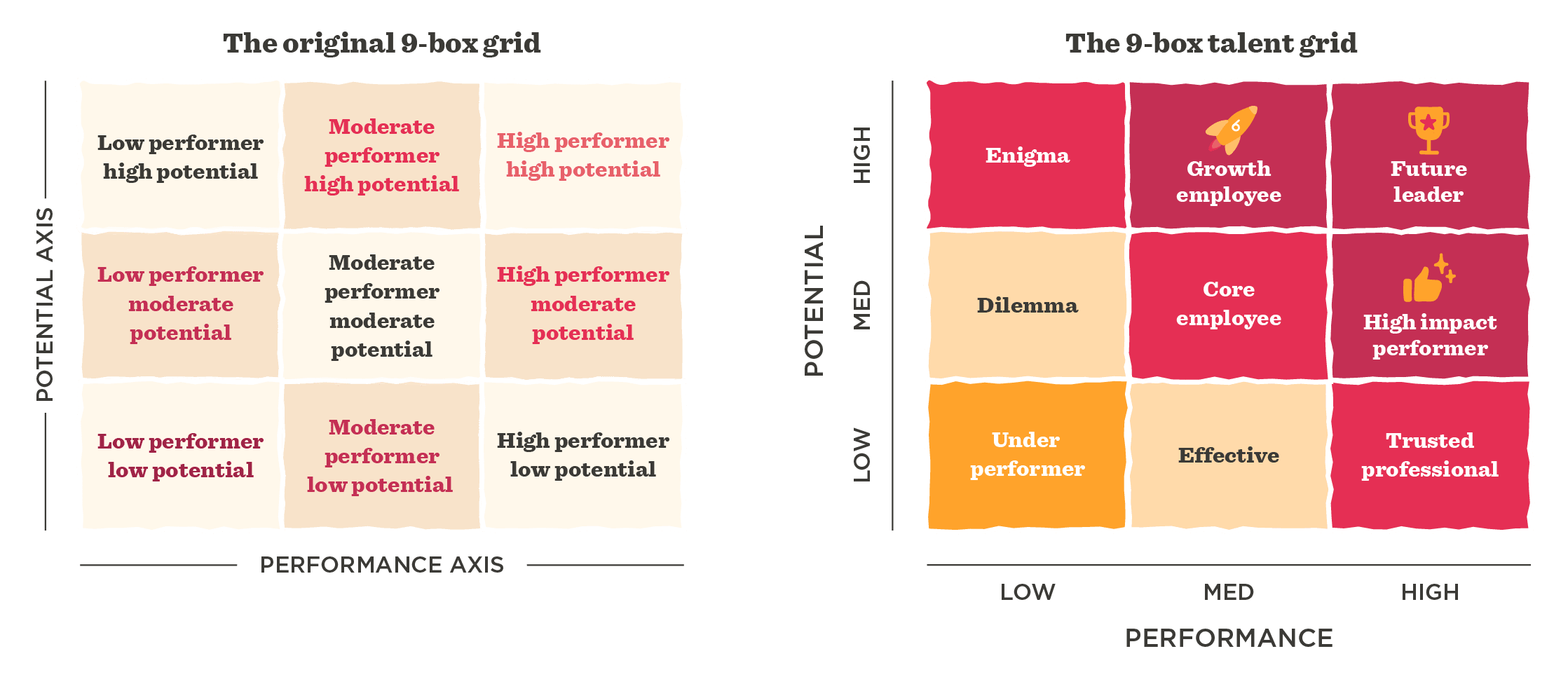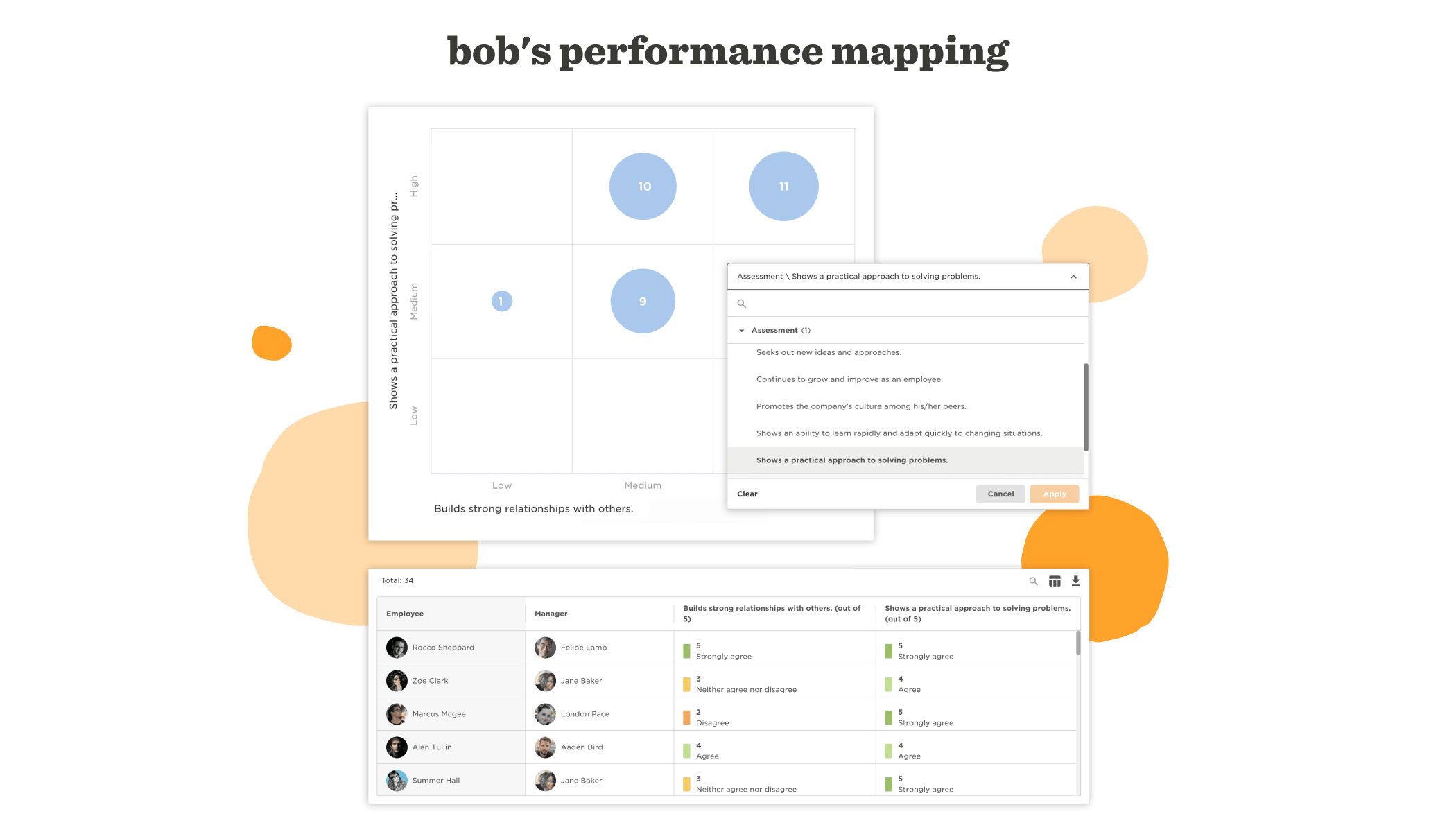Many companies use performance reviews as part of their process of measuring performance. These reviews are commonly structured to generate numerical scoring or professional behavior scores—commonly referred to as performance ratings, which HR and managers can use as a basis for evaluating employees. They can also help to highlight those that make a strong contribution and a meaningful impact within the company. Some organizations also use these scores as a basis for decisions on merit increases or promotions.
One common method used by companies for visualizing employees’ performance and impact, which has become somewhat of a standard, is the nine-box talent matrix. The nine-box was originally created by McKinsey in the early 1970s for GE, a company with 175 business units, as a method for strategically evaluating which business units GE should keep and develop and which business units should be divested. This model has since been adopted as a tool used by companies for performance management of employees by mapping employee impact and contribution according to two attributes—their performance and their potential. A score is given for each, and then the employee is mapped on the nine-box, a 3×3 matrix that measures “potential” on the y-axis, and “performance” on the x-axis.

The original 9-box grid
This standard 9-box uses “potential” on the y-axis and “performance” on the x-axis and displays literal classifications of employees based on their scores. For example, “Low performer/high potential” or “Moderate performer/moderate potential.”
The 9-box talent grid
This 9-box grid also uses “potential” on the y-axis and “performance” on the x-axis. However, it shows definitions for each box—how companies interpret an employee’s placement in any of the nine boxes. So, for example, an employee placed in the bottom left box (a low performer and showing low potential) is considered an “underperformer,” while an employee placed in the top right box (high performer showing high potential) is considered a “future leader” by the company.
Mapping employees on the nine-box grid
Once employee evaluations are mapped on the 9-box grid, it gives HR and other decision-makers a clear view of who in the organization is currently below, meeting, or exceeding their performance expectations and where they stand in terms of meeting their potential.
While this may sound like a straightforward process, it can be problematic. Many managers find it difficult to differentiate between their employees’ performance and their potential. It’s also rare to find employees that score very high for their performance but show very low potential or show great potential but perform poorly.
Another possible issue lies in the fact that some companies have quotas requiring managers to designate a certain percentage of their employees to each box. Those employees that are assigned to the bottom left box may find themselves at risk of termination due to their apparent low performance and low potential when, in fact, they might actually not belong there, and without the quota system would probably be assigned to the middle box. In cases such as these, the nine-box can become a discouraging tool, creating misunderstanding and misalignment between managers and employees.
Recommended For Further Reading
Thinking outside the traditional nine-box
Despite the drawbacks of the nine-box, it does serve a clear purpose. Mapping employees on a grid offers a visual, holistic view of a company’s employees, which helps decision-makers with succession planning—evaluating their current talent and identifying their future leaders. Many of our customers have requested that we add a similar tool to Bob, and we have listened. We are, therefore, happy to announce the addition of Bob’s performance mapping to our talent module.
Introducing Bob’s performance mapping
We see Bob’s performance mapping as a tool that managers and HR can use to start meaningful conversations as part of the employee performance evaluation process.
Because performance reviews can often be biased or subjective—while one manager may be more generous and give their employees a four or a five out of five, another may tend towards giving only a three out of five. This can cause discord within a company, with employees from some departments receiving generally lower scores than those from other teams. Bob’s performance mapping can help to start a dialogue, enabling managers and HR to review each employee together to ascertain that they received an unbiased review and were evaluated fairly.
Another important aspect of Bob’s performance mapping is that, in contrast with the traditional nine-box model that is limited to evaluating only performance and potential, Bob’s performance mapping can use any two attributes chosen by the company in order to analyze their employees.
Bob takes the scores from any two scaled questions and uses them to plot the employee on the grid. If several questions address performance or any other attribute, Bob takes the average score from each question to calculate a final score for that attribute.
Each of the employee’s scores is then mapped on the grid, providing decision-makers with a visual representation that shows all employees. The results can be filtered by team, department, or site, enabling them to drill down and compare different groups from within the company. In contrast with standard reports that analyze one review criteria at a time, a two-dimensional grid such as that used by Bob’s performance mapping can analyze two scores for each employee at the same time.

Bob helps companies simplify a process that can be very technical to do the traditional way using spreadsheets. Bob’s performance mapping is automatically generated from the employee review process, which saves a lot of time and effort. You can also add additional information from Bob to help when evaluating employees, such as their tenure and who their manager is, providing a more in-depth view of each employee. This flexibility allows for additional evaluation and a bigger picture.
Once HR and managers are aligned on where all employees are placed within the grid, the company can share the results with each individual employee or internal stakeholders, confident that the process was unbiased, and that each employee received a fair score.
Five tips for getting the most out of performance mapping
Performance mapping, when done correctly, can help HR and managers ensure a fair and objective performance review process.
We’ve put together five tips to help you get the most out of Bob’s performance mapping:
- Find different criteria to use on your performance map other than “performance” and “potential” to discover more about your employees. For example, you can use “collaboration and teamwork” with “potential” or “performance” and “shows a positive attitude.”
- Choose review criteria that are relevant to your company and that you care about. If “engagement and creativity” are important to your company, then make sure to map those criteria, rather than ones that are not important to you.
- Customize the criteria for different departments in your company to increase their relevance. So, for example, use “creativity” and “engagement” for marketing and “attention to detail” and “willingness to go the extra mile” for product management.
- Provide training for managers on how to perform unbiased performance reviews.
- Create a program that leverages the talent knowledge you have collected for development, merit, management, and other purposes. Most employees will rank in the “core employee” group. Develop plans for those that don’t.
Get mapping!
We’re passionate about providing HR leaders with the best tools for managing their people and creating opportunities for growth in their jobs and in their careers. In line with the flexibility of our platform, Bob’s performance mapping is fully customizable, enabling organizations to choose which attributes they want to use for evaluating their employees. We are sure that this new feature will help start important conversations between HR and managers during the performance management process, ensuring that the performance review process is conducted fairly, and helping companies view their employees in a holistic way.


